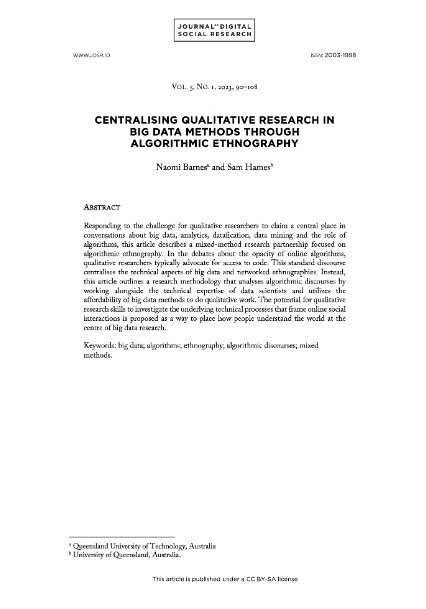Centralising Qualitative Research in Big Data Methods Through Algorithmic Ethnography
DOI:
https://doi.org/10.33621/jdsr.v5i1.129Keywords:
big data, algorithms, ethnography, algorithmic discourses, mixed methodsAbstract
Responding to the challenge for qualitative researchers to claim a central place in conversations about big data, analytics, datafication, data mining and the role of algorithms, this article describes a mixed-method research partnership focused on algorithmic ethnography. In the debates about the opacity of online algorithms, qualitative researchers typically advocate for access to code. This standard discourse centralises the technical aspects of big data and networked ethnographies. Instead, this article outlines a research methodology that analyses algorithmic discourses by working alongside the technical expertise of data scientists and utilizes the affordability of big data methods to do qualitative work. The potential for qualitative research skills to investigate the underlying technical processes that frame online social interactions is proposed as a way to place how people understand the world at the centre of big data research.
References
Bancroft, A., Karels, M., Murray, Ó. M., & Zimpfer, J. (2014). Not Being There: Research at a Distance with Video, Text and Speech. In Big Data? Qualitative Approaches to Digital Research (Vol. 13, pp. 137–153). Emerald Group Publishing Limited. https://doi.org/10.1108/S1042-319220140000013009
Barnes, N. (2021). The social life of literacy education: How the 2018 #phonicsdebate is reshaping the field. The Australian Educational Researcher. https://doi.org/10.1007/s13384-021-00451-x
Castles, A., Rastle, K., & Nation, K. (2018). Ending the Reading Wars: Reading Acquisition From Novice to Expert. Psychological Science in the Public Interest, 19(1), 5–51. https://doi.org/10.1177/1529100618772271
Cheek, J. (2021). Big Data, Thick Data, Digital Transformation, and the Fourth Industrial Revolution: Why Qualitative Inquiry Is More Relevant than Ever. In Collaborative Futures in Qualitative Inquiry. Routledge.
Christian, B., & Griffiths, T. (2017). Algorithms to Live By: The Computer Science of Human Decisions. HarperCollins GB.
Christin, A. (2020a). Algorithmic ethnography, during and after COVID-19. Communication and the Public, 5(3–4), 108–111. https://doi.org/10.1177/2057047320959850
Christin, A. (2020b). The ethnographer and the algorithm: Beyond the black box. Theory and Society, 49(5), 897–918. https://doi.org/10.1007/s11186-020-09411-3
Eubanks, V. (2018). Automating Inequality: How High-Tech Tools Profile, Police, and Punish the Poor. St. Martin’s Publishing Group.
Eyman, D. (2015). Digital Rhetoric: Theory, Method, Practice. University of Michigan Press.
Kelly, A. (2021). A tale of two algorithms: The appeal and repeal of calculated grades systems in England and Ireland in 2020. British Educational Research Journal, 47(3), 725–741. https://doi.org/10.1002/berj.3705
Losh, E. M. (2009). Virtualpolitik: An electronic history of government media-making in a time of war, scandal, disaster, miscommunication, and mistakes. MIT Press.
Mills, K. A. (2018). What are the threats and potentials of big data for qualitative research? Qualitative Research, 18(6), 591–603. https://doi.org/10.1177/1468794117743465
O’Neil, C. (2016). Weapons of Math Destruction. Crown Publishing Group.
Pasquale, F. (2015). The Black Box Society. Harvard University Press.
Pasquale, F. (2020). New Laws of Robotics: Defending Human Expertise in the Age of AI. Harvard University Press.
Pearson, P. D. (2004). The Reading Wars. Educational Policy, 18(1), 216–252. https://doi.org/10.1177/0895904803260041
Sarkar, S. (2021). Using qualitative approaches in the era of big data: A confessional tale of a behavioral researcher. Journal of Information Technology Case and Application Research, 23(2), 139–144. https://doi.org/10.1080/15228053.2021.1916229
Webb, P. T., Sellar, S., & Gulson, K. N. (2020). Anticipating education: Governing habits, memories and policy-futures. Learning, Media and Technology, 45(3), 284–297. https://doi.org/10.1080/17439884.2020.1686015

Downloads
Published
Issue
Section
License
Copyright (c) 2023 The Authors

This work is licensed under a Creative Commons Attribution-ShareAlike 4.0 International License.



